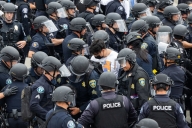You have /5 articles left.
Sign up for a free account or log in.

skynesher/E+/Getty Images
Railing against “indoctrination” in academia has become a favorite pastime for people and politicians along the political spectrum. This accusation is the justification behind removing an entire discipline from general education curricula in Florida. It lies behind banning books across libraries and K-12 schools. And it partly explains the sad state of college course catalogs, which have been whittled down until they resemble emaciated half-reflections of their former glorious selves, in these times of fiscal and political uncertainty for many institutions. In less overt and explicit ways, it also lies behind the ban on “political statements” at a liberal arts institution like Barnard College.
The assertion at the center of claims about colleges indoctrinating students is that professors don’t teach students how to think, they teach them what to think. This criticism forms the basis of Virginia governor Glenn Youngkin’s request to review syllabi for diversity-themed courses at George Mason and Virginia Commonwealth Universities. Florida governor Ron DeSantis believes professors have been trying to “indoctrinate and stuff.” Others accuse academia of unbridled “social activism.” Some critics simply assert the seemingly politically neutral and, to many, commonsensical claim that professors should be focused on teaching students “how to think for themselves.”
This claim underlies Caitlin Flanagan’s recent essay in The Atlantic, “Colleges Are Lying to Their Students” (adapted from the introduction of her book, On Thinking for Yourself), in which she argues that professors are more interested in teaching students what to think than how to think. Flanagan asserts,
“A teacher should never do your thinking for you. She should give you texts to read and guide you along the path of making sense of them for yourself. She should introduce you to the books and essays of writers who disagree with one another and ask you to determine whose case is better.”
But learning how to think can’t stop there. Nor at “expos[ing] students to scholarly works from a variety of political or ideological frameworks”—the pedagogical method of choice offered by a new Indiana law that would deny tenure and promotion to professors who are “unlikely” to follow this approach. Such an approach to “free inquiry” and “intellectual diversity”—one that seeks to end “viewpoint discrimination” by including all viewpoints—fails to take into account that professors are not merely curators of readings; we are also trained in analyzing and assessing the rigor and quality of arguments and evidence. How can we teach students how to assess or evaluate someone’s arguments without conveying judgments about the merits of those arguments? This is how we teach our students the distinction between opinion and academic inquiry, modeling the use of methodologies that yield some actual intellectual verdicts. Learning how to determine whose argument is better is not a skill that can simply be absorbed via osmosis by being exposed to readings.
Giving students readings on “both sides” of climate change, evolution or the Holocaust, hoping that they come to the conclusion that these phenomena/events are real or that climate change demands action or the Holocaust is a moral atrocity, is an unreasonable expectation. While some may find this controversial, we think that facts, reason and logic, on their own, are actually never sufficient to establish the truth of any moral position at all (nor, for that matter, are they always readily discernible from lies, unreason and ill logic). This is because the domain of right and wrong does not overlap perfectly with the domains of science and logic. As we have probably all experienced, it is possible for people to agree on a set of facts and the rules of logic and still disagree, for perfectly reasonable reasons, about moral matters. This means we must sometimes try to persuade each other of what to think using some methods that are not purely logical, including by having students “try on” particular ideas, or practice certain lines of argument.
As the rise of white nationalism, antisemitism and Islamophobia suggests, the idea that a value-neutral pedagogy focused on exposing students to facts and logic and “both sides” of arguments is sufficient for sustaining a multicultural democracy is naive, at best. We also need to express our condemnation and make those ideas socially unacceptable. We also ought not to let people think all on their own when they are in the grip of such terrifying beliefs. Asking a white supremacist to consider “What is the best argument of the other side?”—the seemingly value-neutral question Flanagan reports her father routinely asked her while growing up—is not a recipe for moral transformation.
“The truth wins out in the marketplace of ideas.” Some admirable Enlightenment thinkers surely thought that, but no one living through this current era of easily disseminated enticing and conspiratorial falsehoods could think that truth has a chance without intervention by those who have the training to discern good research from bad, facts from opinion, evidence from propaganda. We rightly must care about what our students think. The bare-bones model of “thinking for oneself” and considering the best argument(s) of the other side, or reading a variety of ideological and political viewpoints, is not close to being up to the tasks at hand, which include responding in real time to cultures of disinformation and attempting to persuade others, for instance, that we need to take action on climate change or take a moment to think about the implications of free and powerful artificial intelligence.
The various bills and laws insisting on “intellectual diversity,” and banning critical race theory and diversity, equity and inclusion, in Florida and a number of other states, reinforce the mistaken view that indoctrination by professors is the biggest problem in higher education today. This perspective entirely misses the mark on what’s ailing American higher education. It’s not that students’ ability to think for themselves is at risk from what professors do or say in the classroom. The biggest threat to free inquiry at colleges and universities currently comes from censorship and political interference in academia. From campus administrations curtailing student protests, to trustees and politicians imposing an ideological litmus test on professors in the guise of “intellectual diversity,” while dictating our curricula and our campus programming, censorship has come to academia. And its flanks are advancing from the right and the left, led by politicians, donors, alumni, administrators and trustees—not professors.







.jpg?itok=YusUVfky)
